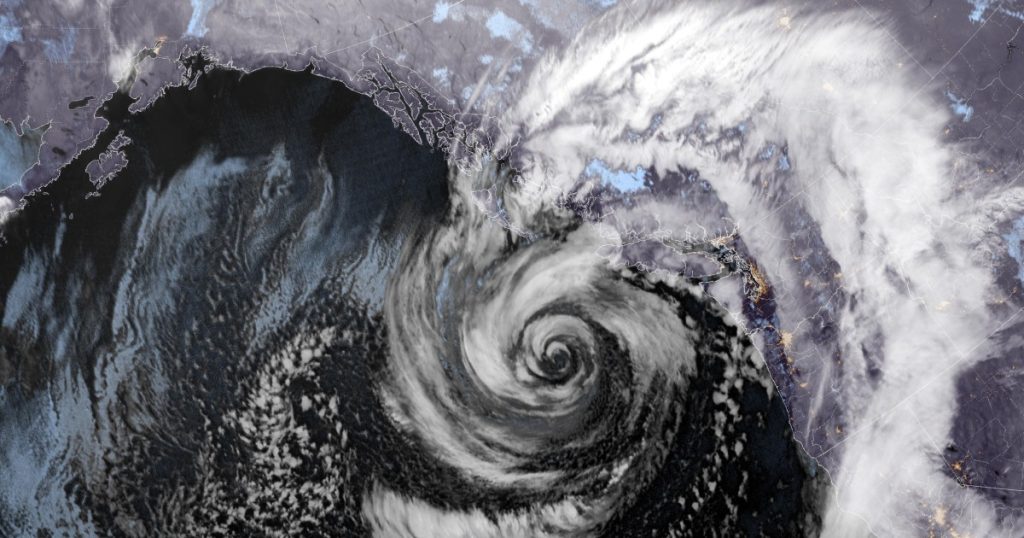Summarize this content to 2000 words in 6 paragraphs Two people were killed near Seattle and more than a half-million homes and businesses were left in the dark Wednesday in the wake of back-to-back storms that battered the Pacific Northwest.The system — described as a “bomb cyclone” for the sharp, quick drop in pressure adding to its power — brought high winds, rain and snow, falling trees and downed power lines throughout western Washington on Tuesday night and Wednesday morning.Snow, freezing rain and blizzard conditions blanketed much of eastern Washington as residents were warned to travel carefully Wednesday. Major route Interstate 5 southbound was closed in southern Oregon to the California border because of blizzard conditions, the Oregon Department of Transportation said.A woman in her 50s was killed when a tree fell at a homeless encampment in Lynnwood around 7 p.m. PT Tuesday, according to South County Fire, which provides emergency services in Snohomish County, north of Seattle.About the same time, a resident of the Bridle Trails neighborhood in Bellevue, a suburb of Seattle, called to report a tree had crashed into his house, killing his wife, firefighters said. “The caller was transported to safety until conditions near the home improved,” the Bellevue Fire Department said. “We are thinking of the family, and community, which we know are impacted by this death.”NBC affiliate KING of Seattle broadcast images of cars smashed by falling trees. A public bus was hit, but no passengers were on board, and the driver escaped unhurt. In some places, winds were strong enough to be classified as hurricane-strength.“There are so many trees and power lines down, we would be posting the locations till the lights turn on. Stay home and stay safe!” Snohomish Regional Fire & Rescue said Tuesday night on X. “Trees are coming down all over the city & falling onto homes. If you can, go to the lowest floor and stay away from windows. Do not go outside if you can avoid it,” the fire department in Bellevue said on X.The National Weather Service station in Seattle was itself damaged in the high winds.More than 700,000 homes and businesses in the state lost power, according to the tracking website poweroutage.us. By late Wednesday afternoon, there had been some improvement, but the number of electricity customers without power was still more than 300,000.Firefighters in Puget Sound rescued two people who became trapped when a tree fell onto their trailer. While one person was retrieved quickly, it took an hour to rescue the second, Puget Sound Fire said. Both were taken to a hospital for treatment. The atmospheric river event already above California is set to bring “extreme rainfall totals” and will linger through the end of the week, the weather service said. Ten to 15 inches of rain is due to hit the northern California coast and inland mountain ranges, which is “likely to increase the threat of life-threatening flash flooding, rock slides, and debris flows,” the agency said.To make matters worse, a separate storm is set to develop and rapidly strengthen off the Northwest coast Friday, helping amplify the atmospheric river effect.Effects were already felt Wednesday. There were power outages in Northern California near the Oregon border, chains were required on Interstate 80 in the Sierra Nevada, and parts of Interstate 5 were closed due to snow, with limited traffic when it reopened, authorities said. In the North Bay of the San Francisco area, a frontal boundary of the atmospheric river was “nearly stalled out” Wednesday evening, and heavy rain was forecast to continue into Friday, the National Weather Service for the region said. By Wednesday night, parts of Marin County had received more than 3 inches of rain over 24 hours, and one location in Napa County saw over 5 inches, the agency said.Canada has also faced strong winds, with gusts of 101 mph recorded Tuesday night at Vancouver Island, wind speeds associated with a Category 2 hurricane.Experts have warned that climate change is worsening the atmospheric effect. A warmer atmosphere can hold more moisture, boosting the potential for warmer, wetter and more intense atmospheric river storms with greater flood risks and higher costs.Patrick SmithPatrick Smith is a London-based editor and reporter for NBC News Digital.Kathryn Prociv, Josh Cradduck, Lindsay Good, David K. Li and Phil Helsel contributed.


